The Controversial Art of Sally Mann
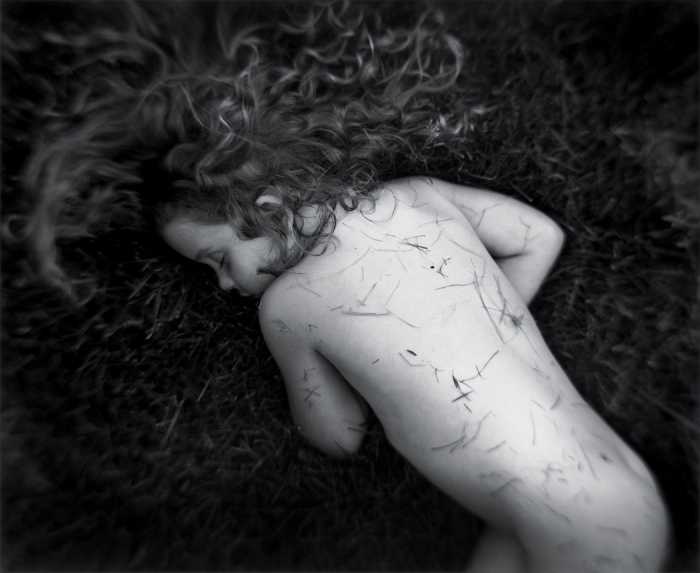
Artist Sally Mann photographed her three children–Emmett, Jessie, and Virginia–every summer from their infancy in the mid-1980s until they reached puberty in the 1990s. The resulting images, which made up Mann’s series, Immediate Family, were taken on the family’s 400-acre farm deep in the woods of rural Virginia and chronicled the cuts and bruises and, most prominently and controversially, the nudity of the three children as they swam and played throughout the summer. Even today, more than twenty years after the series’ initial publication, Sally Mann is most well-known for her provocative depictions of her children’s injuries and nakedness, times when they grappled with death and darkness, as well as the everyday occurrences of childhood, such as playtime and bedwetting. These images, which confront commonly held notions of childhood innocence, have created controversy both inside and outside of the art world, particularly with regards to the nude images.
Photography vs. Pornography: Critical Responses
Critics raised concerns over the sale of Mann’s provocative work, which elicited “largely uninformed responses about child pornography and abuse” 1. Common criticisms revolved around “gendered assumptions” about a mother’s role as a protector 2, the consent (or lack thereof) of the children as subjects, and the possibility that these images could provoke inappropriate actions among viewers. The nudity was also an issue for publications that wanted to publish Mann’s images. The Wall Street Journal ran a photograph of 4-year-old Virginia with black bars over her eyes, breasts, and genitals, and even the most radical art magazines refused to publish an image of a nude Jessie swinging on a hook.
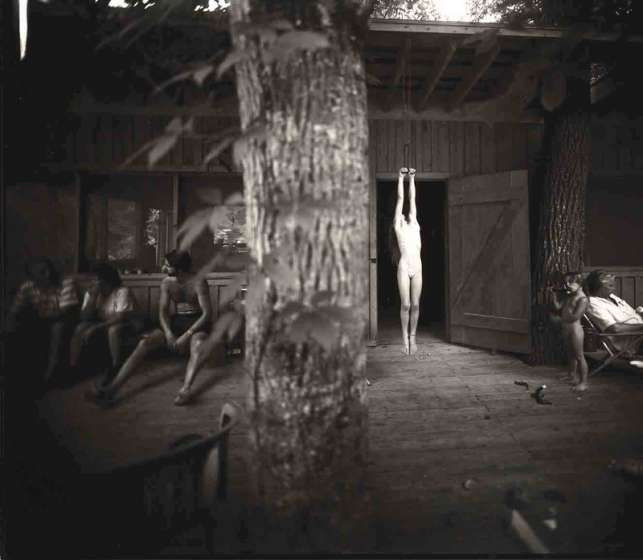
A prosecutor that Mann sought advice from warned her of the possibility of legal action against her. She was not pursued on charges, however, and lawyers like Edward de Grazia from the Benjamin Cardoza School of Law in New York have fought to protect her art under the First Amendment. Despite concern raised by the touchy subjects depicted in Immediate Family, those who appreciate her work argue that Sally Mann’s photographs of her nude children are not unethical because they epitomize the essence of the individual, they exhibit a break in parental and societal trends with regards to sexuality, and they fit within changing cultural mores that make such images acceptable to many, particularly those who appreciate art. Indeed, many will agree that criticisms of Mann’s art do not tear it down but rather add meaning by exhibiting the effects that societal pressure has on children and sexuality.
The Beauty Behind the Controversy
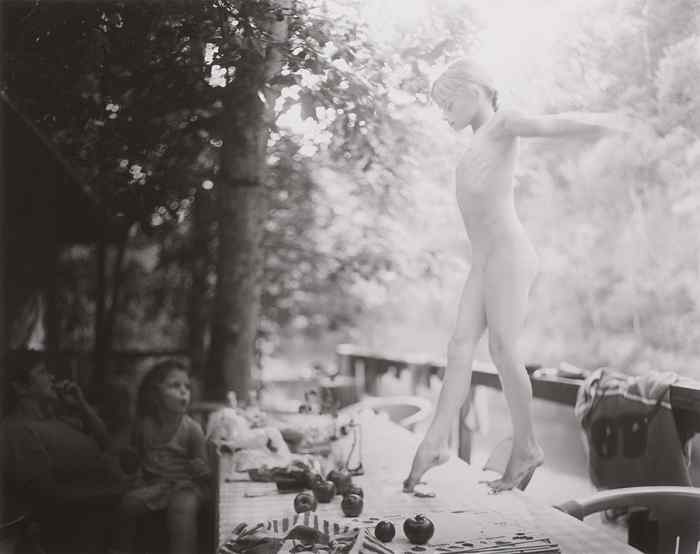
From Mann’s perspective, the naked child represents the most basic, primal way to look at the human body, as it epitomizes the essence of an individual before they develop and society sexualizes them. In this sense, Mann’s art is simultaneously specific to her children as individuals and universal, applying to the life and childhood of all individuals. Her work depicts her three children as representative of all of humanity. It challenges “assumptions of childhood innocence” 3 by showing that children do possess an undeveloped sexuality that they are not yet aware of. That is, they are aware of their bodies, but they do not understand their sexual functions and they do not yet view nakedness and sexuality as shameful. These are things that society teaches them as they grow up.
The nude images from Immediate Family also serve to show that “childhood is a more complicated state than our society has historically accepted” 4. They “point to spaces of childhood that are anything but innocent and that many viewers would prefer not to see or talk about” 5. The photos represent childhood in its entirety, even the darker sides of it, as a reflection of what is to come as the children grow into adults and to refute the idea that childhood is entirely innocent. Viewers of the work are made to hold up a mirror to themselves to reflect on their own individual essences. Mann accomplishes this by using the nude child to show what the human spirit looks like without society’s influences on sexuality.
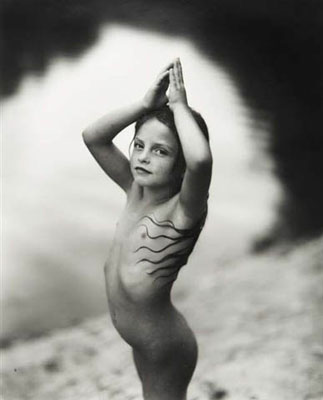
Immediate Family achieves all of this and captures the human spirit in a visual way by depicting different specific moments in a child’s life in a way that is raw and real. As Sally Mann apologist Luc Sante puts it, the children are “naked emotionally as well as physically” 6. The collection includes a combination of both harrowing images of dark emotional times and light, ethereal images of carefree moments. These emotions are coaxed out in their purest form by the children’s nudity, which gets rid of clothing and the weight of society, two things that often serve to cover up emotions. The children are never humiliated by their nakedness; rather, they are depicted beautifully and with the purest of intentions, to show the human essence before society intervenes. Both individually and as a collection, Mann’s photos show the totality of the human experience, “the skull beneath the baby’s skin,” 7 the spirit within the undeveloped sexual form. Because the children are not yet sexually developed, the images are not about their sexual parts. This allows for a deeper look into the spirit of the individual. The images are sensual and give viewers an intimate look at the individual child’s life, but they also offer them insight into their own lives and childhoods.
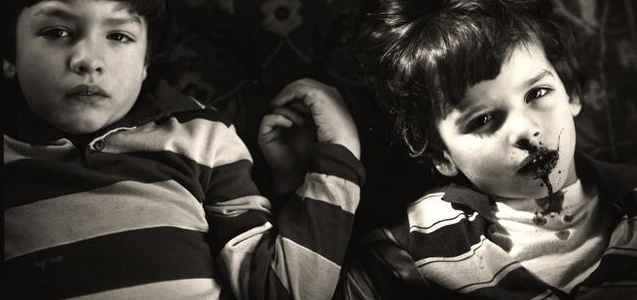
The Nude Child and Changing Cultural Mores
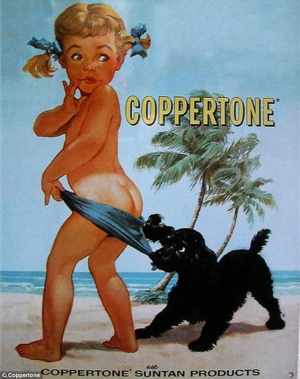
The advent of photography in the early 1800s gave artists the potential to photograph individual nude children and create exact representations of their bodies. Nude children in artistic photographs were not “any child,” as naked children were in paintings and drawings of mothers and children or of cherubs and angels. This has brought up concerns over child pornography and exploitation. Photographers like Jock Sturges and Ejlat Feuer, a student at the International Center of Photography, have faced such penalties as having equipment and negatives seized and being jailed or placed on probation for their photos of nude children. Similar penalties have been imposed on many photographers, despite an apparent lack of prurient intent in many cases.
Still, many personal and cultural products that contain images of nude or partially nude children, such as family photo albums and advertisements, have “historically been about as hazardous a subject matter for representation as sunsets and flowers” 8. That is, proud parents are not jailed for keeping images of their sweet children bathing together. Even companies like Centrum/Whitehall-Munch and Coppertone, whose very public advertisements have utilized images of nude children, have not been as harshly scrutinized as photographers like Sally Mann. The Coppertone girl, an illustration of a girl having her bathing suit bottoms pulled down by a puppy, has actually been reenacted by real children and has even been made into kids’ Halloween costumes.
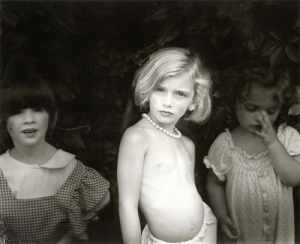
While art like Sally Mann’s has been considered scandalous in the past, changing cultural mores have made it more acceptable to many people. In addition to the fact that the children depicted have grown up, people today are more apt to view nude images as art. The parameters for an image to be considered pornographic are narrowing, as people have become more accepting of nudity and of the idea of child nudity as a form of artistic expression, as long as it is created and exhibited without immoral intent. Even lawyers like Edward de Grazia agree that “there isn’t the slightest question that what [Mann’s] doing is art, so her motives and the artistic value [are] unmistakable” 9.
Many people today, particularly art appreciators, view Sally Mann’s work as art rather than as pornography, which has made it very successful among this group. Despite their controversial subjects, hundreds of Mann’s prints have sold for millions of dollars. Indeed, Mann is a brave and original artist, and “probably no photographer in history has experienced such a burst of success in the art world” 10 as she has.
Works Cited
- James Christen Steward, “The Camera of Sally Mann,” Michigan Quarterly Review, vol. 39 no. 2 (2000): 366. ↩
- Katherine A. Bussard, So the Story Goes (Chicago: The Art Institute of Chicago, 2006), 79. ↩
- Katherine A. Bussard, So the Story Goes (Chicago: The Art Institute of Chicago, 2006), 79. ↩
- James Christen Steward, “The Camera of Sally Mann,” Michigan Quarterly Review, vol. 39 no. 2 (2000): 375. ↩
- James Christen Steward, “The Camera of Sally Mann,” Michigan Quarterly Review, vol. 39 no. 2 (2000): 375. ↩
- Luc Sante, “The Nude and the Naked,” New Republic, vol. 212 no. 18 (1995): 35. ↩
- Luc Sante, “The Nude and the Naked,” New Republic, vol. 212 no. 18 (1995): 35. ↩
- Luc Sante, “The Nude and the Naked,” New Republic, vol. 212 no. 18 (1995): 31. ↩
- Richard B. Woodward, “The Disturbing Photography of Sally Mann.” The New York Times, (1992): 8. ↩
- Richard B. Woodward, “The Disturbing Photography of Sally Mann.” The New York Times, (1992): 1. ↩
What do you think? Leave a comment.










Nicole, great article. Thank you for your research on this artist and how society relates and reacts to these beautifully haunting images.
And thank you for the feedback, Venus!
There is a very meticulous process to her work and I believe that’s why people like myself are drawn to her work. The natural state of Mann’s photographs are some of the most beautiful elements of her work.
Robin,
I agree. It’s interesting how the images are so meticulously crafted and yet so natural. They’re more than just snapshots of what her children happened to be doing at the time, but they aren’t set up, either. Mann really strikes a balance between the dichotomy.
Thanks for the comment!
I shared this article with my friends and colleagues. Had these been National Geographic like photos of naked African tribal children, would anyone have said much of a word? Is it only family photos of naked children from 1st world countries that evoke this sexualized idea for some? How about naked baby photos what exist in probably every single photo album of every reader here? Things to think about.
Wow, thanks so much for sharing!
This article is actually part of a more extensive piece that I wrote. In the longer version, I talk about the nude images of the Christ child that are so prominent in religious art. Such images have been accepted, even celebrated, for centuries.
Your point about photos of African tribal children is another interesting example of that sort of thing. I guess people are less accepting of Mann’s images because they showcase her children as individuals, whereas a nude image of the Christ child is only speculative, and images of nude African tribal children are more representative.
But what makes these things more acceptable than Mann’s celebration of the human spirit and individuality? And who’s to say that her images aren’t just as representative of something as images of nude African children featured in National Geographic?
Even more things to think about!
i love sally mann. she’s so cool. great article.
Thanks! So do I!
Great piece! I was familiar with Mann as a name and a scandal but seeing you write so elegantly about her work is refreshing. The section where you compare her work to family photography is particularly interesting. The images that are taken at home can be brought out for friends and family and flashed at graduation parties but they are never criticized (except , perhaps by the subject!). I think that this definitely brings up the issue of how sexuality is viewed inside and outside the home where the body remains the same but the sexual mores differs. It is a great way to problematize the gaze and our personal feelings. Fantastic work.
Thanks for the comment! You bring up an interesting point. Perhaps part of what makes Mann’s work so “scandalous” to some is not just its subject matter but also who can view the images.
That being said, I’m happy to expose readers to an opinion of Mann’s work that they may not have considered. There are many supporters of Mann’s work out there (Luc Sante, for example), but the images’ scandal has perhaps shrouded these ideas from view.
Very interesting article! The line between art and pornography is certainly blurry, even if some people may suggest they’ll “known porn when they see it.” It is interesting that Mann was attacked for taking pictures of her own children, when there are people out there who photograph children for their own perverted purposes. There are a lot of issues that play out on the image of naked body, particularly a child’s body, and perhaps it is when these issues collide that there is controversy.
Absolutely! There is no agreed upon line between what is considered pornography and what is considered a “nude.” It’s different for every person, which is why there’s so much disagreement when it comes to Mann’s work.
Thanks for the comment!
The line between art and pornography certainly can be blurry. It all comes down to subjective opinion. This is what makes art an intriguing medium.
A good line from a bad movie I always remember fondly is, “Indecency is just a question of geography.” That seems to be the nature of these photographs, prior to actual discussion of their content. Intimate portraits for general public browsing and perusal.
But the (rhetorical) question, I’d like to know is who, if anyone, did Mann want to see her work? The lay public, critics, art dealers, future parents, her own family, etc? To be read at home, in a gallery, on the subway, in a library?
I wondered what her children think of all this, being the focus of the work, but I get the sense that’s an irrelevant question. This isn’t about them; it’s about us.
It makes sense that you would wonder what the kids think, though. In my research, I discovered that Mann and her husband were completely transparent with their children about Mann’s art. They taught them that nudity wasn’t something to be ashamed of.
Before the images’ publication, they also had the children evaluated by a psychologist to ensure that they understood the circumstances and that they had a healthy mindset about nudity.
But you’re right. This is more about society’s understanding of the work than it is about the children’s. That quote relates perfectly to this discussion.
Thanks for the comment!
Man that actually makes me more queasy about Mann then. I can teach a young person who depends on me for their well being all sorts of attitudes, since what else do they have to compare with and what would would they if they disagreed with me?
I have no reason to believe Mann had any malicious intent, but going with theme of perspective and judgment, it’s not hard to see why some might see the acclimation you describe as her being responsible or perhaps being manipulative.
It’s a wilderness of mirrors.
Wonderful discussion, I enjoy these points of view and completely agree with the comments regarding geographical location as to the degree with which the debate of art vs. pornography; those locations with the puritanical resonance are more apt to view these works with the veil of pornography whereas, it may be considered hedonistic norm for those others outside of their realm.
Great article. It is interesting not just to think about the controversy surrounding these images and what these reflect about our understanding of what art may or may not encompass, but the effect that art has, or may not have, on its subject/s. Just because the children may have been accepting of the practice at the time does not mean that they will into the future. As well, it touches on how much rights a parent has in shaping their child. None of this is to say that the photographs or their taking are inherently bad or necessarily, harmful, but, just that it is interesting to think about the effects of art on other people, especially the malleable minds of children.
Seems odd that her reasoning that her kids ran around naked all the time was because there was nobody else around for miles to see them naked, so why not let them run naked….and yet she publishes photos of them naked for the world to see.
The sort of persons who see obscenity in nudity when none is intended are reflecting more of themselves than the art.
Bravo Sally Mann. True art.
In the times of ‘selfie everywhere’ the true art of photography is like a diamond among average stones.
Sally Mann is one of the most talented and memorable artists on our time. Taking beautiful moments in real life and documenting them.
I respect Sally Mann for her artistic vision, and i would not call her art pornographic, because porn is supposed to be erotic and exploitative, and that was not really her intentions in her photos. With that said, there is just an automatic creepy factor when you depict a nude child, especially when considering we are living in dark times, when child pornography in no laughing matter.
That is, unfortunately, one of the larger negative results of the photography – a man stalked the family for years after the photos were published.
Remarkably beautiful work, particularly considering the – er – “challenging” subject matter.
I am delighted to see Sally Mann receive well deserved attention. Her work is remarkable, both highly accomplished and unerringly honest.
The hammering and hammering about Mann’s “using” and “manipulating” her kids is embarrassing.
Her work with that style of photography is phenomenal and I hope to one day just apporach her level of artistry.
Great article Nicole! This is the first I am hearing of Sally Mann’s artwork and I think I can understand her perspective on using the children as a pure image before society begins to sexualize their bodies.
Thank you so much for this fascinating article. I have never heard of Mann before, but I am intrigued by her work. I agree that confining children to standards of sexual innocence can be damaging to a young person who reaches puberty and then struggles to grow up and come to terms with their sexuality. The overlap between sexuality and art is complex, and deserves to be continually written about and discussed.
Ms. Mann is one of the most talented artists currently living and working in the US.
Her work is gorgeous. Never seen much like it. I can see HOW people would think her photographs are “distasteful” or “controversial”, but I’m pretty sure those opinions are more so rooted in impulse than logical thought.
astoundingly accomplished photography.
Just . . . wow. This was a great article–because it was critical, had a distinct viewpoint, and acknowledged the ambiguity of what Sally Mann created while arguing for art.
I mean, the photographs are wonderful, and it’s an interesting dilemma that’s presented: we would have no problem whatsoever with a mother taking those photographs of her children and keeping them as a family record, but once she tried to present them to the wider world as art, as something valuable . . . then the ethical objections start rolling in. While I personally applaud what Mann was trying to achieve, I have to wonder how her kids feel about these photos being made public. That’s really the only concern I have about Mann’s art.
Extraordinarily brave artist.
This work is visually stunning. I think the notion of the child nude is a cautious topic; especially in the age of exploitation. From an objective viewer’s gaze, I get a sense of the captured spirit of childhood freedom, the innocence of unashamed nudity, and a sense of honesty. I think the latent function of this type of work is to edify the representation of human form, de-sexualize the human body, and strip photography back to sculptural basics. This work reaches across the boundaries of time and context, revealing a maternal understanding of the vulnerability of children, and by extension, the exposed raw nature of being a mother.
Its ironic that Mann describes the naked child as the purest human form before it is sexualized by society, and then society comes along and sexualizes her work. Its refreshing to be able to consider the deeper meaning behind something “scandalous” without being labeled as controversial yourself.
I loved this article. Often, I reflect on ways in which we can view the human in its purest form, taken away from society’s influences. This point especially caught my attention, “The photos represent childhood in its entirety, even the darker sides of it, as a reflection of what is to come as the children grow into adults and to refute the idea that childhood is entirely innocent”.
My inquiries often lead to this question of what is the human? What are our natural characteristics, and how can we understand our nature when we live in a society that conforms us into civilized, proper beings.
Love Sally Mann’s work!
Only my second article, and already I’m loving this site! Can’t believe I’ve only now discovered it.
For anyone who loves (or hates!) Sally Mann’s work, I highly recommend you read her autobiography “Hold Still” (pub. 2015). If you love her, this will give you incredible insight into her life and how it shaped her work (be prepared for some roller coasters and unexpected events!).
And if you hate her/her work, it will do all that while explaining her intent, interests, and frustration in trying to portray various ideas to a society that was so stuck in a close-minded and confining space. Hopefully, when you’re done, you’ll have a new appreciation for what she did and continues to do!
Great use of secondary sources. I loved this topic. I think every child has gone through that phase where clothes become an evil entrapment. It’s very thought provoking, since some people react so violently when children do children things (like walking around naked). It is strange how sharp the contrast is as well; some see it as normal and beautiful, while others see it as a source of pornography, perversion, and abuse. I for one think this relates to how we raise children today, keeping them in an overly sheltered environment.
In any case, this article succeeded in stirring the thought-pot and in being informative.
Excellent, thought-provoking article that explores both sides of the controversial issue. Nicole, you do a great job of explaining Mann’s reasoning and connecting it to society on a larger scale, allowing readers to see the implications of being too quick to judge images like this.
Sally Mann is one of the most important photographers of the 21st century. Her work not only explores the depths of the human psyche, but is executed with meticulous skill and a true understanding of her craft.
It has always puzzled me how one can mistake artistic expression for pornography. In the former, the naked body is presented as an authentic and natural behavior, closely integrated with the immediate context of the narrative. In the latter, it is presented as a focus for seduction, an invitation for contact. Those who see seduction in the naturally authentic, impose their own layers of personal expression over those things which are innately innocent.
Law enforcement is going to focus on overt sexual abuse, coercion, signs of violence in child pornography; innocent naked snapshots aren’t at risk. Mann’s shots often cross into a gray area of poses ostensibly benign, but which might hint at more to a number of viewers. This may elevate some, but diminish other aspects of her art. They are decidedly not all mere documents recording natural moments of childhood from a neutral vantage point.
“Hayhook” is so obviously posed to be suggestively ambiguous that it belies her claim that “the naked child represents the most basic … way to look at the human body, …the essence of an individual before they develop and society sexualizes them.” Only other children are going to see images like this without extra overtones; are they intended to provoke, embarrass, bring out guilty responses in adult viewers?
Biology sexualizes all of us; society suppresses or magnifies the reams of codes and pressures passed through history and cultures, affecting our beliefs and some, but not all of our responses to our sexual proclivities.
The commerce of her art enters the domain of exploitation of minors, and whether the kids were willing participants, and were guaranteed later compensation for their involvement. Entirely separate from assessing the artistic merits, but critical in assessing the artist-as-parent.
This article is greatly informative. I knew nothing about Sally Mann until now and I want to know more. Especially in the United States, nudity is often looked down upon. It seems that Mann’s art has been breaking barriers and the best art not only contains an easily disputed meaning but also invites change or action. Lovely photos and a great article.
I teach photography and a course on the History of Photography. I found this article to be well researched and incredibly engaging. Your discussion about specifically the nude in regards to children is not frequently written about and changes the discussion about her work that is usually focused on debating the definition of pornography. Thank you for a fantastic article.
Very engaging and insightful article. I have taught visual rhetoric in my courses and Sally Mann’s work has ignited many conversations on Western society’s sexualization of the human body. I found your arguments on the sexualization of children’s bodies informative. Thank you for this article.
Thank you for this thoughful and intelligent article. I have been a huge fan of Mann’s work since I first saw it as a child myself, and feel that her photographs speak to something primal and profound if the viewer allows them to. It’s sad that representations of her own children in their natural forms led to such allegations against her, but I think it saws more about society than about Sally Mann.
Great article! It is interesting that many of Mann’s critics have gotten up-in-arms about the nude depictions of her children “corrupting the idea of childhood innocence”, when really the children are fine and safe…
What is concerning about her art is not the nudity of her children, but people’s interpretations of that nudity. Some adults cannot view a child’s naked body as being representative of childhood innocence… They seem to believe that all nakedness has sexual connotations, when really, as you pointed out, what Mann is trying to show us is the purity of childhood- the “human essence before society intervenes”.
On the one hand, her critics have opened up an interesting debate, and it is great that people are more aware of issues of childhood abuse and exploitation. On the other hand, one must view the work in context- just because a child is naked, it does not mean that they are sexual. In fact, as Mann said herself “I think childhood sexuality is an oxymoron”
Yes beautiful photography. And true art. However, I am disturbed that children of this are not in any way capable of giving their permission to be photographed nude or for their nude images to be sold and published worldwide. We don’t live in isolated areas of rural Virginia, we live in a world of pedophiles, murderers, stalkers and ugliness where the majority of people care only about their own needs and desires. These children were put at risk. I’m not sure how these two realities can be reconciled. The pursuit of art versus the reality of humankind.
I think it is interesting to see the change in views towards child nudity as artistic expression. When photographing one’s children, the artist creates a work that is pure, innocent, and everything but sexual. Those looking at this work and seeing problems about the children’s’ consent and sexuality need to look past that, as the artist has. Context in these artworks is so important.
I think it is interesting to see the change in views towards child nudity as artistic expression. When photographing one’s children, the artist creates a work that is pure, innocent, and everything but sexual. Those looking at this work and seeing problems about the children’s’ consent and sexuality need to look past that, as the artist has. Context in these artworks is so important. Great article!
Good article with an interesting critical lens. I do enjoy art that pushes the limits, however, children are always going to be the most controversial topic, particularly in photography. I believe this is rightfully and justifiably so. This series attempts to use the children’s nudity to explore concepts that only adults can really comprehend. By playing to the idea that it is society that imposes certain taboos on the human form, I do find this to be contradictory as it does just that through the exploitation of her children. This is very different to naked photos in family albums. This was made for an international audience. I feel this is indeed coming back to artists wanting to push the limits for the sake of it. For me pieces like this just enforce societal ideas of sexuality and in fact play to the wider capitalist and neoliberal paradigm. The artist is looking to advance her work, standing and notoriety at any cost, not taking the agency of her children into account. We live in a world full of really sick people, so putting something like this out there is going to cause controversy. The artist knew this and played to it for her own benefit. In my opinion. For the children themselves I think this also has the potential to affect them negatively. Imagine your school peers finding a series of naked photographs of you?
An extremely interesting article, Nicole. The aura felt in Mann’s photographs complements the purity and simplicity of childhood, and I believe she captures this exceptionally. I do agree however, that her intent is not always seen by adults, and that their interpretation is what may cause controversy.
This was an interesting article, but it felt very short. There wasn’t really anything said about the pathologizing of sex in Western culture, which would have provided a solid background on which to centrally frame people’s issue with the art, and I was surprised that nothing was said about Mann’s children’s views (insofar as they are known) about their mother’s photography.
Otherwise, it inspired me to read more about the artist. Thanks for writing and sharing 🙂
Great article/analysis of Sally Mann’s work! I wasn’t that familiar with her art before, so reading this was incredibly informative and enlightening. I’m definitely going to read more about her from now on. Thank you!
Nicole, I love how you write with such strong conviction. Personally, I have always loved Sally Mann’s work. I gravitate towards artists who completely cut open themselves and create something that is undeniably them.
A lot of the criticism towards these photographs originate from the way people were raised, especially how they were taught about bodies. I was raised to look at my body as a representation of anatomy and not sexualize it. Therefore, when I see her children naked, I see a child living without judgment and insecurity.
Great analysis.
I don’t question that a depiction of a naked body, any naked body, can be art, but at the same time, it makes me fairly uncomfortable that Mann’s is the kind of art that so clearly depicts individuals who could not have given their full and informed consent to being depicted and having their images made publicly available at the time of their exhibition and publication. It’s something that makes me uncomfortable about a great deal of art depicting existing individuals, regardless of whether they are nude or not, and something I clearly need to think about at much greater length in order to sort out the intricacies of my own position on.
It was a great pleasure to learn about Sally Mann for the first time through your article, Nicole. I have a couple of reactions, (which are entirely unrelated to to one another). 1) The confrontation of commonly-held notions about childhood innocence is fascinating to me because I have at least one distinct personal memory of experiencing, as a child, a sense of latent sexuality that I did not understand. 2) I find myself comparing Mann’s art with Nick Ut’s 1972 Pulitzer Prize-winning photo of the napalm girl. Interesting that it was not deemed necessary to black-out her nipples and genitals.
Thank you, Ms. Williams! I am currently writing a manuscript on different attitudes toward child nudity. Your comments on any-child subjects caused me to do some thinking. I just finished writing a whole page on the subject.
In return, I would like to share a recent insight of mine. I read a comment which Sally Mann made to The New York Times Magazine in 2015: “Once the work was out in the world, I was puzzled as to why that sensuous beauty should be signposted as controversial, while magazine pages were filled with prurient images of young girls, all aimed at selling commercial products.”
I think I can explain that: It so happens that men tend to associate nudity with sex more than do women. That seems to go for hetero-, homo-, and pedosexual men and women, and in all six permutations. Sally Mann probably didn’t realize that. I didn’t either, until I read her article and started to do some digging.
I started to wonder what women use for masturbatory stimuli. I found three Websites in which women were asked that same question. The respondents said that they wanked over videos, movies, and literature. There was no mention of nude photographs.
This gender difference wrought havoc in the editorial office of Playgirl Magazine, which attracted both male homosexuals and women heterosexuals. The male subscribers wanted a generous display of flesh, but the women subscribers didn’t. When the editors tried to comply with one group, the other group complained.
I also wondered about the rare but existent women who were attracted to children the wrong way. I found a study which Louanne Lawson conducted in 2008. The study found that such women “rarely in favor of masturbation or pornography,” but rather “found sexual satisfaction in intimate relationships.”
I don’t think Mann has very many unwelcome fans in Lawson’s sample.
If I am looking at these images through the eyes of a mother, then I can understand the inspiration to capture this brief time in a person’s life — a time when we are most human let’s say. Still, I cannot help but feel horribly uncomfortable at the reality of naked children being photographed. These children do not have full comprehension of their mother’s project, so they cannot properly consent to this. How will they feel about these images as adults?
great article! I enjoyed reading it
It’s pretty simple. Had Sally Mann been a man, she would have faced far greater risk that her photographs would be considered obscene and therefore illegal. Since she was the mother of the children involved, that was also a point in her favor. Had she been an unrelated man taking those pictures, she would be in jail today. Thus, it really isn’t so much society’s changing mores (as this article suggests) that have kept her out of prison, but rather the specific circumstances and location in which she did her art. Bear in mind that community standards also play a part in the legal analysis of possible obscenity. Put her in Mississippi, make her a man and unrelated to the children, and I doubt she’d get away with it.